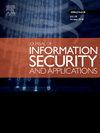基于hmac的密钥派生函数伪随机性的新证明(RFC 5869)
IF 3.7
2区 计算机科学
Q2 COMPUTER SCIENCE, INFORMATION SYSTEMS
Journal of Information Security and Applications
Pub Date : 2025-08-05
DOI:10.1016/j.jisa.2025.104179
引用次数: 0
摘要
密钥派生函数(key derivation function, KDF)在密码系统中是至关重要的,它旨在派生出一个甚至可能缺乏随机性或被攻击者部分知道的初始密钥源,并生成安全的秘密密钥。基于HMAC的密钥派生函数(HKDF)建立在HMAC上,据称具有伪随机比特生成器(PRBG)属性,尽管目前文献中没有正式的证明。本文对RFC 5869中规定的HKDF密钥派生方案中的伪随机性进行了全面的分析和评估。我们证明了HKDF方案在假设输入盐或初始键控材料(IKM)是随机的情况下获得了PRBG特性,并且我们进一步假设底层HMAC函数是伪随机函数(PRF)。此外,我们展示了在需要HKDF生成大量密钥的扩展场景中的伪随机性的结果。具体来说,我们根据NIST SP 800-22中概述的统计标准对HKDF方案的随机性进行了各种实验评估。最后,对HKDF进行了灵敏度评估,结果表明,IKM输入中每改变1比特,衍生密钥(OKM)中的比特数就会发生大约50%的变化。这一结果表明HKDF具有强随机性和高灵敏度。我们的研究结果不仅提供了新的证据来证实HKDF的伪随机性,而且提高了算法的整体安全性。本文章由计算机程序翻译,如有差异,请以英文原文为准。
New proofs for pseudorandomness of HMAC-based key derivation functions (RFC 5869)
The key derivation function (KDF) is crucial in cryptographic systems, aiming to derive an initial key source, which may lack even randomness or be partially known to attackers, and generate secure secret keys. The HMAC-based key derivation function (HKDF), built on HMAC, is claimed to have Pseudo-Random Bit Generator (PRBG) properties, though no formal proof exists in current literature. This paper conducts a comprehensive analysis and evaluation of the pseudo-randomness within the HKDF key derivation scheme, as specified in RFC 5869. We demonstrate that the HKDF scheme attains PRBG properties under the assumption that either the input salt or the Initial Keying Material (IKM) is random, and we further assume the underlying HMAC function is a Pseudo-Random Function (PRF). Additionally, we present results showcasing the pseudo-randomness in an extended scenario where HKDF is required to generate a large number of keys. Specifically, we perform various experimental evaluations of the randomness of the HKDF scheme based on statistical standards outlined in NIST SP 800-22. Finally, a sensitivity evaluation of HKDF is conducted, revealing that a change of 1 bit in the IKM input results in an approximate 50% change in the number of bits in the derived key (OKM). This outcome signifies the robust randomness and high sensitivity of the HKDF. Our findings not only offer novel proof confirming the pseudo-randomness of HKDF but also enhance the overall security of the algorithm.
求助全文
通过发布文献求助,成功后即可免费获取论文全文。
去求助
来源期刊

Journal of Information Security and Applications
Computer Science-Computer Networks and Communications
CiteScore
10.90
自引率
5.40%
发文量
206
审稿时长
56 days
期刊介绍:
Journal of Information Security and Applications (JISA) focuses on the original research and practice-driven applications with relevance to information security and applications. JISA provides a common linkage between a vibrant scientific and research community and industry professionals by offering a clear view on modern problems and challenges in information security, as well as identifying promising scientific and "best-practice" solutions. JISA issues offer a balance between original research work and innovative industrial approaches by internationally renowned information security experts and researchers.
 求助内容:
求助内容: 应助结果提醒方式:
应助结果提醒方式:


